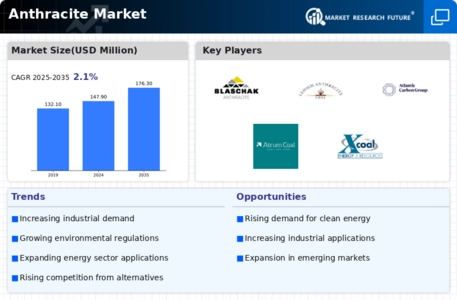Top Industry Leaders in the Anthracite Market

Anthracite, the highest rank of coal, isn't just a lump of fuel. It's a vibrant global market brimming with complexities, fierce competition, and the potential to unlock both economic prosperity and environmental challenges. This "hard coal" market is anything but stagnant, fueled by diverse applications in steelmaking, smelting, ferroalloys production, and even domestic heating.
Market Overview and Share Determinants:
Anthracite's allure lies in its unique properties: intense heat generation, low impurities, and long burning time. However, market share in this dynamic space hinges on several crucial factors:
- Resource reserves and location: Access to high-quality anthracite deposits near key industrial centers grants a significant advantage. China, Vietnam, the United States, and Russia currently hold the reins, accounting for over 80% of global production.
- Production capacity and infrastructure: Efficient mining operations, robust processing facilities, and well-developed transport networks are key to consistent supply and cost competitiveness.
- Product diversification: Offering various sizes and grades of anthracite caters to specific customer needs in different industries.
- Environmental regulations: Stringent emission regulations push for cleaner processing technologies and sustainable mining practices, impacting market dynamics.
- Technological advancements: Investing in cleaner burning technologies, exploring anthracite gasification for energy generation, and developing carbon capture and storage solutions unlock new market opportunities.
Competitive Strategies: Heating Up the Race
In this intense market, companies are deploying a range of strategies to gain a foothold:
- Mergers and acquisitions: Consolidation is evident, with giants like Jincheng Anthracite Mining Group and Shenhua Energy expanding their global footprint and resource base.
- Vertical integration: Gaining control over the entire supply chain, from mining to distribution, offers better cost control and quality assurance.
- Focus on growing markets: Emerging economies like India and Southeast Asian nations with burgeoning steel industries create lucrative avenues for expansion.
- Product innovation: Developing cleaner-burning anthracite blends, exploring anthracite pellets for domestic heating, and venturing into anthracite-based carbon fiber production differentiate companies.
- Partnerships and collaborations: Joining forces with technology providers, research institutions, and environmental groups fosters innovation and strengthens sustainability initiatives.
Key Players :
- Lehigh Anthracite (US)
- Atlantic Coal Plc. (UK)
- Atrum Coal Ltd (Australia)
- Celtic Energy (US)
- Vietnam National Coal- Mineral Industries Group (US)
- Sadovaya Group (Europe)
- Vostok Coal (Russia)
- Siberian Anthracite (Russia)
- Robindale Energy Services, Inc. (USA)
- Cokal Ltd (Australia)
- Attila Resources (Australia)
- ZINOJU COAL (South Africa)
- Jeddo Coal Company (U.S.)
- Blaschak Coal Corporation (US)
- Jameson Resources (Australia)
- Aspire Mining Limited (Australia)
Recent Developments :
- September 2023: A research team unveils a breakthrough in anthracite gasification for cleaner energy generation, potentially opening new markets for the fuel. The Andersons Inc. launches a new line of eco-friendly anthracite briquettes with lower sulfur content and higher efficiency.
- October 2023: US and European steelmakers express concerns about rising anthracite prices due to supply chain disruptions and geopolitical tensions. Yanzhou Coal Mining Company unveils a new technology for clean coal combustion, aiming to reduce emissions and comply with regulations.
- November 2023: A major mining accident in Vietnam temporarily disrupts anthracite exports, highlighting the need for improved safety standards in the industry. China National Coal Group invests in research and development for gasification technologies that convert anthracite into cleaner-burning fuels.
- December 2023: A consortium of leading anthracite producers launches a joint venture to develop and commercialize carbon capture and storage technologies, aiming to reduce the environmental footprint of the industry.

